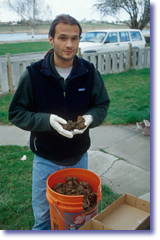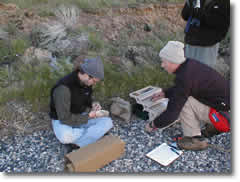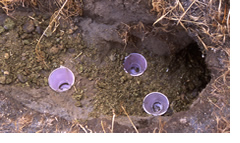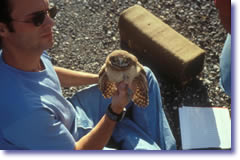Matthew Denman Smith
mdsmith@ag.arizona.edu
EDUCATION
2004-M.S. Wildlife Science, The University of Arizona, Tucson, AZ
1997-B.A. Biology Earlham College, Richmond, Indiana
RESEARCH EXPERIENCE
In 1998, I worked as a research assistant in northern Maine on a study of the effects of an industrial forest on the behavior of black-throated blue warblers. In 2000, I was hired as the project coordinator for Dr. Conway's study on the demography of burrowing owls in south-central Washington, and on his study of the efficacy of installing artificial burrows on golf courses for burrowing owls.
MASTER'S RESEARCH
Birds often collect non-food materials to use in nest-building. Yet, some birds collect materials that serve functions other than holding and insulating young. Burrowing owls routinely collect dried mammal manure and scatter this dried manure at the entrance to their nest burrow and in the tunnel leading to the nest (video clip). Many alternative hypotheses have been proposed to explain the function of this manure-scattering behavior, however, none of them have been tested rigorously. I examined the function of manure-scattering behavior by testing 4 alternative research hypotheses. I found no support for the widely-accepted olfactory-concealment hypothesis that states manure covers the scent of owls from potential predators. I also found no support for the mate-attraction hypothesis that states manure is used to indicate individual quality, and is thus used by females to choose among perspective mates. Some predictions of the burrow-occupied hypothesis, that manure serves as a signal to indicate occupancy and reduce costly agonistic interactions, were upheld. But, results were not statistically significant. My data support predictions of the prey-attraction hypothesis. Pit-fall traps at sampling sites with manure collected 76% more insect biomass than pit-fall traps at sampling sites without manure. The manure-scattering behavior of burrowing owls appears to function to attract insect-prey for sentinel males, incubating females, or nestlings.
click here to see manure scattering behaviour




- Smith, M. D., and C. J. Conway. 2003. "Are burrowing owls selective in use of nest-lining materials. Impacts of Urban Development in Southern Arizona's Desert Environment Conference", Tucson, AZ.
- Smith, M. D., and C. J. Conway. 2002. "On metabolic rate and Seasonal Reproductive Output in Birds. Ecological Society of America Annual Conference", Tucson, AZ.
- Smith, M. D., and C. J. Conway. 2002. "Selective use of nest-lining materials by Burrowing Owls. North American Ornithological Conference", New Orleans, LA.